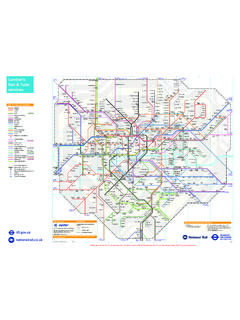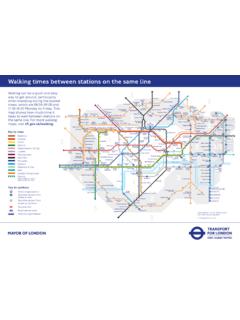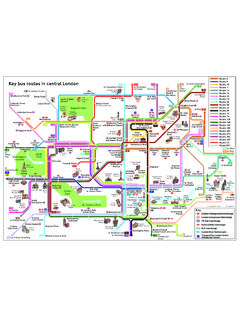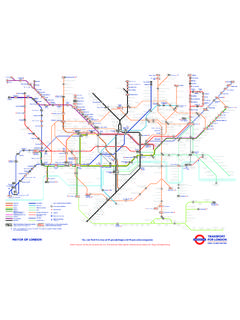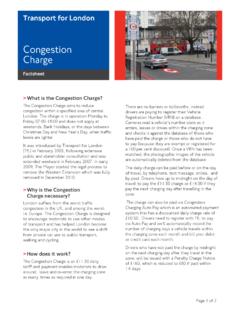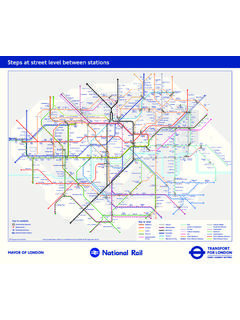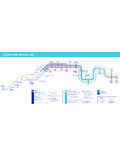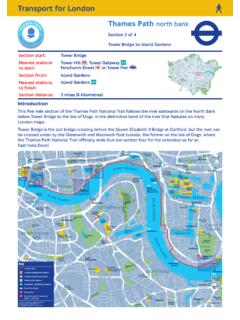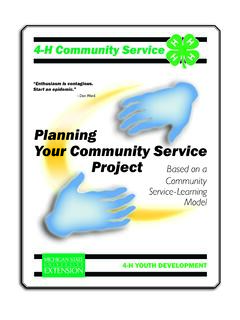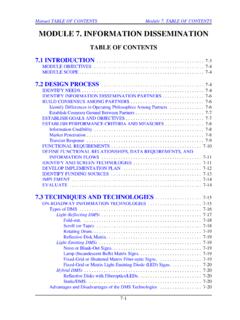Transcription of LONDON CCLING DESIGN STANDARDS
1 LONDON CYCLING DESIGN STANDARDS2014 EDITIONMAYOR OF LONDONC ontentsLondon Cycling DESIGN StandardsThe LONDON Cycling DESIGN STANDARDS (LCDS) sets out requirements and guidance for the DESIGN of cycle-friendly streets and spaces. It should be used by those who shape the environment through planning and street DESIGN as well as engineers designing cycle-specific forms one part of TfL s Streetscape Toolkit, and should be read in conjunction with the other constituent documents: Streetscape Guidance LONDON Pedestrian DESIGN Guidance Accessible Bus Stop DESIGN Guidance Kerbside Loading Guidance Station Public Realm Urban DESIGN GuidancePublished by Transport for LONDON , 2014 ContentsChapter 1 DESIGN requirementsChapter 2 Tools and techniquesChapter 3 Cycle-friendly streets and spacesChapter 6 Signs and markingsChapter 4 Cycle lanes and tracksChapter 7 Construction, including surfacingChapter 5 Junctions and crossingsChapter 8 Cycle parkingThis chapter provides an introduction to the DESIGN STANDARDS and a summary of key requirements.
2 1. DESIGN requirements[Chapter 1] DESIGN requirementsLondon Cycling DESIGN 2 Summary of 3 Using 4 Document 5 DESIGN 6 Guiding of service for to Level of Service LCDS141. 3 .1 Delivering high quality and and policy controlVersion 1 (Dec 2014) PublishedVersion 2 (Sept 2016) Minor amendments following publication of TSRGD (2016) IntroductionThe Mayor has set out his vision for cycling and his aim to make LONDON a cyclised city. Building high quality infrastructure to transform the experience of cycling in our city and to get more people cycling is one of several components in making this happen. This means delivering to consistently higher STANDARDS across LONDON , learning from the DESIGN of successful, well used cycling infrastructure and improving substantially on what has been done before. It means planning for growth in cycling and making better, safer streets and places for all.
3 Last published in 2005, the revised LONDON Cycling DESIGN STANDARDS (LCDS) sets out the approach needed in LONDON to deliver this step-change in quality and to inform and reinforce borough plans and strategies for promoting cycling. Now comprehensively updated to reflect established and emerging best practice, LCDS is a document that should shape DESIGN options and promote an integrated and ambitious approach to delivering high quality infrastructure for cycling in all parts of LONDON .[Chapter 1] Raising STANDARDS 01 LONDON Cycling DESIGN Summary of requirementsLCDS identifies the DESIGN outcomes desired to deliver the ambitions of the The Mayor s Vision for Cycling (2013), reflecting the Mayor s Roads Task Force report, The vision and direction for LONDON s streets and roads (2013). It requires that all infrastructure delivered through TfL-funded programmes applies the following: Guiding principles, which help clarify how the Mayor s Vision for Cycling should be delivered Levels of service, which are ways of measuring the quality of DESIGN outcomes, both in terms of what they offer for cycling and what they contribute to placesThe requirements for cycling infrastructure proposals delivered through the Mayor s Vision for Cycling, are that they should:1.
4 Demonstrate how the guiding principles have been reflected in DESIGN decisions2a. Deliver the appropriate strategic level of service based on place characteristics as outlined in the Roads Task Force street types approach2b. Meet the minimum standard expressed in the Cycling Level of Service (CLoS) assessment, and any further programme- or project-specific Raising STANDARDS Using LCDSL ondon aspires to be a great cycling city. The application of the guiding principles set out in this document and rigorous attention to achieving higher service levels as a result of new infrastructure are central to this. Street types and the CLoS assessment give the ability to set STANDARDS flexibly but consistently. Those planning and delivering cycling infrastructure are encouraged through this guidance to be bolder, to commit to making better, more attractive streets and spaces for cycling and walking and to experiment with temporary measures where necessary to prove that change is achievable.
5 The overall aim is to plan and deliver a LONDON -wide network for cycling that meets with aspirations for infrastructure that is safe, comfortable, direct, coherent, attractive and consists of comprehensive guidance to support meeting those aspirations, and should be read and understood by all those involved in the DESIGN of infrastructure for cycling, including not only highway planners and engineers but all those who help shape the street environment. While it carries no legal obligation, any decision to depart from its advice should be accompanied by a reasoned justification for doing so and should be discussed and agreed with the relevant highway authority. [Chapter 1] Raising STANDARDS 02 LONDON Cycling DESIGN Document structureThe first two chapters of LCDS cover general DESIGN requirements and techniques for planning and delivering high quality infrastructure. The procedures set out here should be applied in a way that is consistent and proportionate with the scale of intervention proposed.
6 They are intended to help deliver the desired outcomes efficiently and to a high standard, rather than place unnecessary burdens on three covers user requirements for any place, and how those needs may be balanced to create civilised streets and better places for everyone. The remaining five chapters of LCDS consist of detailed DESIGN guidance to support the requirements and principles set out in chapter one. Figure Structure of LONDON Cycling DESIGN Standards123 DESIGN requirements Good DESIGN outcomes for cycling Guiding principles Levels of service by street typeTools and techniques Cycling Level of Service assessment Network planning Scheme deliveryCycle-friendly streets and spaces Better places for everyone Understanding user needs Civilising streets7 Construction, including surfacing8 Cycle parking6 Signs and markings5 Junctions and crossings4 Cycle lanes and tracksLondon Cycling DESIGN DESIGN outcomesThe six core DESIGN outcomes, which together describe what good DESIGN for cycling should achieve, are.
7 Safety, Directness, Comfort, Coherence, Attractiveness and are based on international best practice and on an emerging consensus in LONDON about aspects of that practice that we should adopt in the UK. They are important not just for cyclists but for all users of streets, public spaces, parks and watersides, where investment in cycling has the potential to improve the quality of place. These DESIGN outcomes, illustrated in figure , contribute to broader concepts of placemaking, in particular the principles of good DESIGN set out in National Planning Practice Guidance (2013) and local DESIGN guidance such as TfL s Streetscape future must not be like the past. Even infrastructure designed with good intentions in mind can fail to provide a good level of service to cyclists, as the examples in figure will be measured by the quality of DESIGN outcomes. Improvement therefore needs to be focused on the cycling experience: how safe and comfortable it feels, how direct and attractive a journey is to cycle, and whether cycle routes are coherent and Good DESIGN outcomes 1-3 Good infrastructure should help to make cycling safer and address negative perceptions about safety, particularly when it comes to moving through must be logical and continuous, withoutunnecessary obstacles,delays and diversions, and planned holistically as part of a surfaces for cycling,and transitions from onearea to another, should befit for purpose, smooth, well constructed and well for cycling is important but a narrow advisory cycle lane next to a narrow general traffic lane and guard-rail at a busy junction is not an acceptable offer for track works well on links but requires cyclists to give way at each side road.
8 Cyclists often choose to stay on carriageway rather than take fragmented routes with built-in transitionsbetween on-and off-carriageway facilities arebest avoided, particularly at locations where conflict with other road users is more - Safety2 - Directness3 - Comfort[Chapter 1] Raising STANDARDS 03 LONDON Cycling DESIGN Guiding principlesIt will take consistent commitment to the quality and ambition of cycling infrastructure DESIGN to realise The Mayor s Vision for Cycling. The 20 guiding principles set out below are fundamental to that approach. Working through them can help practitioners to understand what it will take to deliver the Mayor s Vision. They are geared towards learning from what has been done well in the past and tackling the reasons why many previous attempts to deliver good cycling infrastructure have fallen Good DESIGN outcomes 4-6 Infrastructure should be legible, intuitive, consistent, joined-up and inclusive.
9 It should be usable and understandable by all users. Infrastructure should not be ugly or add unnecessarily to street clutter. Well designed cycling infrastructure should enhance the urban infrastructure should be designed to accommodate users of all types of cycle, and an increasing numbers of users over cyclists nor pedestrians benefit from unintuitive arrangements that put cyclists in unexpected places away from the well-intentioned signs and markings for cycling are not only difficult and uncomfortable to use, but are also unattractive additions to the streets have been engineered primarily for use by motor vehicles, it is difficult to make infra-structure for cycling that is legible and adaptable. 4 - Coherence5 - Attractiveness6 - AdaptabilityREQUIREMENT 1: Consideration of the guiding principles should shape the DESIGN of any infrastructure delivered as part of the Mayor s Vision for Cycling.
10 How they are applied will depend on site-specific conditions and on detailed DESIGN , but schemes should demonstrate that these issues have been taken seriously and have informed DESIGN decisions. [Chapter 1] Raising STANDARDS 04 LONDON Cycling DESIGN Standards1. Cycling is now mass transport and must be treated as suchMost current cycle provision is squeezed into spare space or on the margins of roads. It reflects a belief, conscious or otherwise, that hardly anyone cycles, that cycling is unimportant and that cycles must take no meaningful space from more important road users, such as motor vehicles and no longer applies, especially in the centre. TfL s April 2013 cycling census found that 24 per cent of all rush-hour traffic in central LONDON is cycles, and 16 per cent across the entire day, with shares of up to 64 per cent on some main roads. Similar shares apply in inner cycle facilities must be designed to cope not just with these existing levels of use, but with the future we are planning: of further increases in cycling in zones 1 and 2, and of existing inner-city cycling levels starting to spread to the suburbs.

